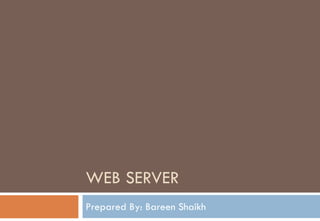
Web Server.pdf
- 1. WEB SERVER Prepared By: Bareen Shaikh
- 2. Topics 5.1 Creating Web Server 5.2 Handling HTTP requests 5.3 Sending Requests 5.4 HTTP Streaming
- 3. Introduction Web Application needs Web Server. Communication between Client & Server using HTTP. IIS web server for ASP.NET web application. Apache web server for PHP and Java web application. Create Node.Js web server for Node.js application.
- 4. Creating Node.Js web server Node.js makes create a simple web server that processes incoming requests asynchronously. Following example is a simple Nodejs web server example var http = require('http'); // http Node.js core module var server = http.createServer(function (req, res) { //handle request }); server.listen(8080); //listen for any incoming requests console.log('Node.js web server at port 8080 is running..')
- 5. Creating Node.Js web server In the above example, http core module is imported using require() function. As http module is a core module of Node.js, no need to install it using NPM. Next step is call createServer() method of http In that specify callback function with request and response parameter. Finally, call listen() method of server object. Which start listening to incoming requests on port 8080. Can specify any unused port here.
- 6. createServer() const http = require('http'); const server = http.createServer((request, response) => { // Task to be done! }); OR const http = require('http'); const server = http.createServer(); server.on('request', (request, response) => { // Task to be done });
- 7. CreateServer() Explanation The function that's passed in to createServer is called once for every HTTP request. It works as a request handler. The server object returned by createServer is an EventEmitter. HTTP request hits the server, node calls the request handler function for dealing with the transaction,request and response
- 8. Simple Hello World Example var http = require('http'); //create a server object: var server=http.createServer(function (req, res) { res.write('Hello World!'); //write a response to the client res.end(); //end the response });server.listen(8080); //the server object listens on port 8080
- 9. HTTP Request and Response The http.createServer() method includes request and response parameters The request object can be used to get information about the current HTTP request e.g.,methods, url, request header, and data. The response object can be used to send a response for a current HTTP request.
- 10. Handling http request The first thing while handling request is to check method and URL, so that appropriate actions can be taken. Node.js makes this relatively painless by putting handy properties onto the request object as follows const { method, url ,header} = request; Parameter: method here will GET/POST/PUT normal HTTP method/verb. url is the full URL without the server, protocol or port.
- 11. Request Body let body = []; request.on('data', (chunk) => { body.push(chunk); }).on('end', () => { body = Buffer.concat(body).toString(); // body has the entire request body, stored in it as a string });
- 12. Request Body explanation request object passed in to a handler implements the ReadableStream interface. This stream can be listened or piped. Data can be read out of the stream by listening to the stream's 'data' and 'end' events. The chunk emitted in each 'data' event is a Buffer. Most probably data going to be string data, the best is to collect the data in an array, At the 'end', concatenate and stringify it.
- 13. Error handling while http request request.on('error', (err) => { // This prints the error message and stack trace to `stderr`. console.error(err.stack); }); The request object is a ReadableStream, which is an EventEmitter An error in the request stream presents itself by emitting an 'error' event. If event listener is not handle in program then the error will be thrown.
- 14. Overall Program of HTTP request const http = require('http'); http.createServer((request, response) => { const { headers, method, url } = request; let body = []; request.on('error', (err) => { console.error(err); }).on('data', (chunk) => { body.push(chunk); }).on('end', () => { body = Buffer.concat(body).toString(); }); }).listen(8080);
- 15. HTTP Response response object is an instance of ServerResponse which is a WritableStream. It contains many methods for sending data back to the client. HTTP Status code HTTP status code on a response always be 200. Not every HTTP response warrants this such as response.statusCode = 404; // Tell the client that the resource wasn't found.
- 16. Setting Response Headers Headers are set through a convenient method called setHeader() response.setHeader('Content-Type', ‘text/html'); Explicitly Sending Header Data with method called writeHead() which writes the status code and the headers to the stream. response.writeHead(200, { 'Content-Type': ‘text/html’});
- 17. Sending Response Body response object is a WritableStream writing a response body out to the client. response.write() method is used to write streams. response.write('<html>'); response.write('<body>'); response.write('<h1>Hello, World!</h1>'); response.write('</body>'); response.write('</html>'); response.end() OR response.end('<html><body><h1>Hello, World!</h1></body></html>');
- 18. Error handling while http response response.on('error', (err) => { // This prints the error message and stack trace to `stderr`. console.error(err.stack); }); The response object is a WritableStream, which is an EventEmitter. An error in the response stream presents itself by emitting an 'error' event. If event listener is not handle in program then the error will be thrown.
- 19. Put overall code together of http request and response
- 20. Simplified overall program const http = require('http'); http.createServer((request, response) => { let body = []; request.on('data', (chunk) => { body.push(chunk); }).on('end', () => { body = Buffer.concat(body).toString(); response.end(body); }); }).listen(8080);